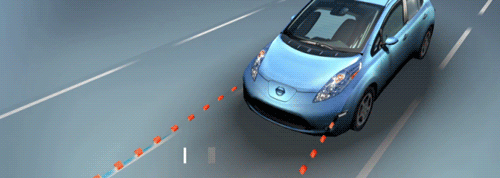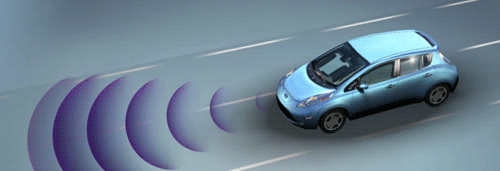The Nissan roadmap for making cars that drive themselves a reality
Driverless cars have been envisioned for decades, but on this week’s “TechKnow,” Kosta Grammatis gets to see science fiction become reality as he takes a ride in Nissan’s autonomous prototype, a model of their electric LEAF which can drive and park itself. “You no longer have to operate your car,” Grammatis says. “It drives you to work, it drives you home.”
Nissan is racing to be the first company to commercially distribute a fully autonomous car. As Japanese engineer Tetsuya Iijima tells Grammatis, their goal is to have driverless cars on the road by the year 2020.



Laser scanners sense objects around the LEAF prototype, a front radar panel can see the road up to 200 meters (about 656 feet) ahead, and rear radar panels range up to 70 meters (230 feet). The car also includes sonar capabilities to help with parking and cameras on each side of the car.
Autonomous mode, which can be activated by pushing a button on the driver’s side, gives auditory notifications so the driver knows what the car is doing and why. Cameras read the lines on the road to keep the car on course, and can even sense red lights and stops signs, adjusting accordingly.
The cameras and lasers are also used to sense any obstacles that suddenly appear on the road, like a child or dog running into the street. Once an obstacle is detected, the car reads its surroundings to determine whether to swerve or brake to avoid an accident.

“There’s been a lot of discussion about this, whether they’re going to be safe or not,” Grammatis says. “But right now, they’re doing research that is basically taking a racecar driver’s skill and putting it inside the car. If you hit black ice while you’re driving, you don’t know what to do, you can’t react fast enough. But imagine if you had the equivalent of a racecar driver, with all that experience—it could just take over and drive for you.”
It can park itself, too. Grammatis and Iijima climb into the back seat as the car finds an empty spot, then uses the SONAR sensors to back in safely.

While the technology is essentially ready, the biggest obstacle to autonomous cars is still the human factor, Specifically, researchers are worried about human reaction time when the car transitions from autonomous mode back to the hands of the human driver. At the Stanford University Automotive Innovation Facility, scientists use a simulator to test human reaction time and variables involved when operating a driverless car.
Stanford professor Clifford Nass tells Grammatis that the most dangerous moment in an autonomous vehicle is the moment when the car shifts control from itself to the driver. “Drivers are totally disoriented and they’re being asked to absorb an enormous range of activities, an enormous range of things going on, to get what we call ‘situational awareness’ where there was none,” he says. “That turns out to be an extraordinary challenge.”





Kosta takes a ride in the simulator, complete with EEG electrodes on his head to measure brainwaves, an eye tracker to see where his sight line is, a heart rate monitor and hand sensors to determine what Nass describes as “autonomic arousal,” a measurement of a person’s excitement and readiness.
“A good driver is neither too excited nor too calm,” Nass explains.
Grammatis asks if sensors will be required for all future drivers of autonomous cars, but Nass thinks that technology will advance past that necessity.
“Eventually, cars will completely drive themselves,” he says.
“This simulator was built to help us better understand ways to alert the driver that autonomous mode is being switched,” Grammatis explains, as he cruises down a virtual street.
Grammatis focuses on his cell phone while autonomous mode takes over, but when the car alerts him to regain control, the transition is harder than he expects.
“I just crashed into about 12 cars because I wasn’t paying attention,” he admits. “I was going really fast.”

Driverless cars will revolutionize travel for everyone, but especially for those who aren’t currently able to drive due to a handicap or other physical restriction. Steve Mahan is almost completely blind, but Google gave him the chance to get behind the wheel again, allowing him to “drive” their first autonomous car. Mahan described the experience as “incredibly normal and abnormal at the same time.
“All the things that you do as you drive just immediately come back,” he tells Grammatis, “even though I can’t see.”
“This is some of the best driving I’ve ever done,” Mahan jokes from the driver’s seat of the Google car, as he stops at a drive-thru and cruises around his neighborhood. While behind-the-wheel he sought out “normal” driving activities, things he has missed since losing his eyesight.
When asked if he thinks he will be driving again is his lifetime, Mahan is happily optimistic. “Absolutely,” he says.
Grammatis is positive as well. “Nissan is committed to a 2020 date for having driverless cars on the road,” he says. “It’s on its way.”
Watch "TechKnow," Sundays at 7:30PM ET/4:30PM PT on Al Jazeera America.
Error
Sorry, your comment was not saved due to a technical problem. Please try again later or using a different browser.